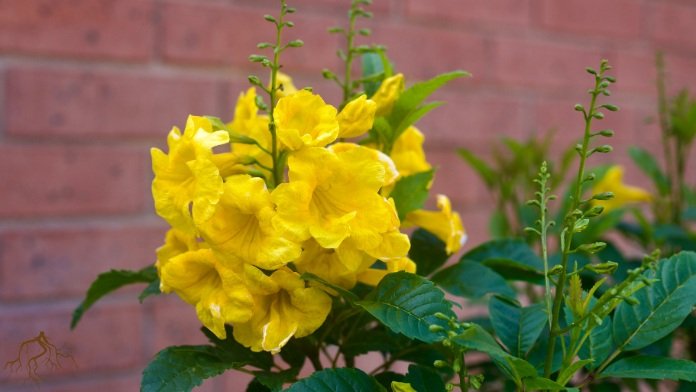
The Hope (Tecoma stans) has many names. Esperanza plants may also be known as yellow bells or hardy yellow trumpets. They bloom from spring to autumn. At the same time, Esperanza perennials are grown in the landscape as shrubs or container plants for their beauty.
Esperanza plants add a tropical touch to the landscape with their abundant clusters of red, orange, or yellow trumpet-shaped flowers that bloom for an exceptionally long period.
The lightly scented flowers are a favourite of hummingbirds, butterflies, bees and other pollinating insects. Here’s how to grow and care for this exotic plant.
About the Esperanza plant
Botanical Name
Tacoma Stance, sin. Tacoma Alta
Common Name
Esperanza, trumpet flower, yellow trumpet bush, yellow bell, yellow elder, Tacoma plant, ginger-thomas and yellow bignonia. local area
Native to America from South America to Argentina.
The Zone
9-11, although some varieties can survive up to zone 8. Plants may return to the ground over winter in light frost areas.
Height/ Span
Erect and bushy habit. In its native habitat, Esperanza can grow 15 to 30 feet tall and 10 to 30 feet wide, although US dwarf cultivars are generally smaller.
Exposure
full sun
Flowering Time
Spring to frost, with peak bloom in summer. In frost-free climates, the plant blooms almost year-round.
Flowers
Yellow, orange, or red trumpet-shaped flowers are 3 to 5 inches long and lightly scented. Flower clusters produce up to 50 flowers each. After flowering, the plants produce thin bean-like seed pods that turn pale green and brown.
Benefits of Esperanza Plant
Esperanza plants add a tropical feel to the landscape with their abundant clusters of red, orange or yellow trumpet-shaped flowers that bloom for an exceptionally long period.
The lightly scented flowers are a favourite of hummingbirds, butterflies, bees, and other pollinating insects. Yellow Trumpet was used in medicines for diabetes and stomach cramps and was thought to have diuretic and anthelmintic uses. The roots were also used to make a kind of native beer.
Esperanza plant Care
Esperanza plants need to be grown in a warm environment that closely mimics their native environment. The soil should dry out between watering intervals.
Additionally, a water-soluble fertilizer should be applied at least every two weeks for plants grown in containers and about every four to six weeks for plants planted in the ground. Cutting seed pods from Esperanza plants will help with continuous flowering.
Water
Once established, Esperanza is drought tolerant but does well with moderate water. Water regularly, 10 days per week, allowing the plants to dry out in the water. Plants will need more frequent watering during extreme heat and prolonged dry periods. Plants in containers need to be watered more frequently than plants in the ground. Avoid over-watering.
Fertilizer
Plants require very little supplemental fertilizer. Apply a slow-release, all-purpose fertilizer at planting time. To increase the flowering and vigour of plants in poor soil, feed them with an all-purpose granular or liquid fertilizer every month or two during the growing season.
In spring, cover the base with a layer of compost. Potted plants will benefit from applying liquid fertilizer every 4 to 6 weeks during the summer.
Pruning
Esperanza blooms on new wood and requires little pruning. Its shape is milder after peak flowering, from autumn to late winter. Cut off dead or diseased branches at any time of the year.
The plants can be left as shrubs or grown into small trees. Cut the plants back to the ground if they die after a hard frost.
Esperanza, the plant variety
Esperanza” (Tecoma Stans), also known as yellow bell or yellow elder, is a flowering shrub that produces bright yellow, trumpet-shaped flowers. Here are a few popular varieties:
Gold Star Hope
It is known for its abundant and continuous flowering, even in hot climates, with bright yellow flowers.
Orange Jubilee
This variety features orange flowers instead of yellow, giving the common Esperanza plant a unique look.
Fire Bell
A compact Esperanza variety with red-orange flowers, perfect for containers or small spaces.
Mayan Gold
A unique, disease-resistant, prolific variety with vibrant yellow flowers.
Sun Trumpet
A fast-growing variety, often used for hedges or screens, produces clusters of golden yellow flowers.
FAQ
Is the Esperanza plant poisonous?
Animals can become allergic to parts of these plants if they eat them or come in contact with sap from wounded or broken plants. If eaten, parts of the plant can be poisonous.
How tall is the Esperanza plant?
Esperanza can grow 15 to 30 feet tall and 10 to 30 feet wide, although US dwarf cultivars are generally smaller.
Where is the best place to plant Esperanza?
Some afternoon shade is delicate in full sun, but if you plant Esperanza in a shady area, you’ll sacrifice the flowers.
When to plant Esperanza in Texas?
Spring, after the threat of snow, has passed.
RELATED POSTS
View all


